Black, is a more uncommon yet exquisite hair coat color, and a captivating sight in horses.
This color is characterized by a complete black coat – a stark contrast to the commonality of dark chestnuts and bays that are often mistaken for black.
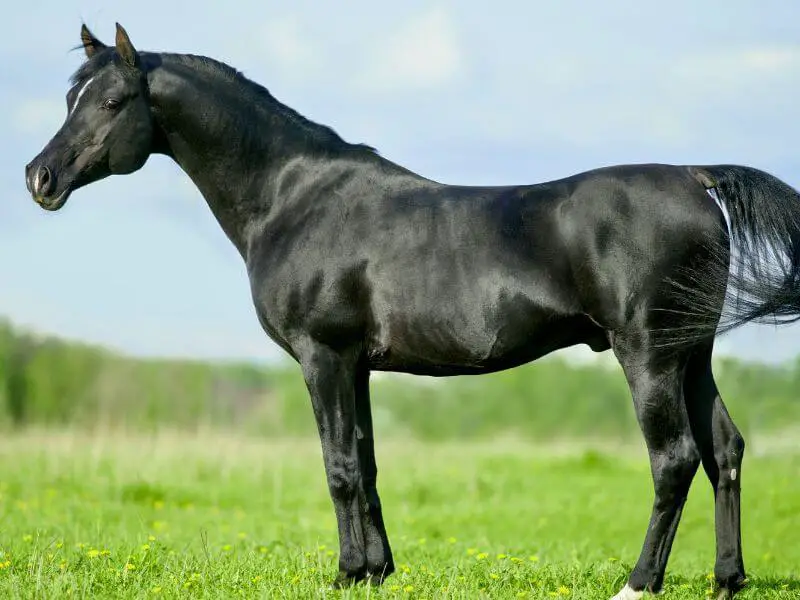
Black Horse Description
Black horses possess a captivating allure with their sleek, dark coats that exude a sense of power and mystery.
Their coat color is characterized by a deep, solid black that often glistens with a metallic sheen, setting them apart from other colors. These horses have dark brown eyes and black skin, creating a striking visual contrast.
True black horses are distinguished by their hair coat, which is entirely devoid of any reddish or brownish hues.
They have a distinct absence of lighter colors, further enhancing their dark and captivating appearance.
Underneath any white markings they may have, black horses can reveal patches of pink skin, adding a subtle touch of delicacy.
It’s important to note that black horses can be susceptible to a phenomenon called “sun bleaching” when exposed to prolonged sunlight and heat.
This can cause their coat to undergo a fading process, temporarily resembling bay or seal brown horses.
However, not all black horses are prone to sun bleaching, and some individuals possess a “non-fading black” coat that retains its deep black hue even under prolonged sun exposure.
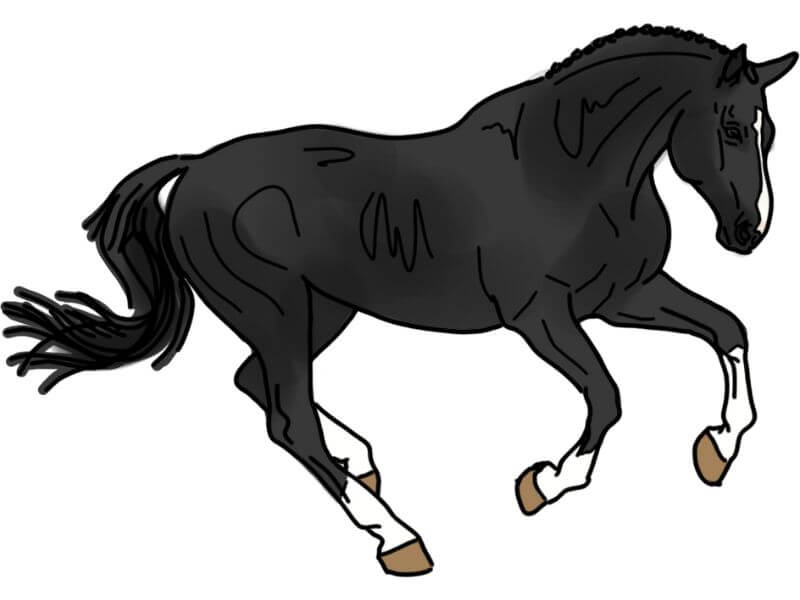
Identifying a Black Horse
When identifying a horse’s base color, white markings, such as those found in pinto and leopard patterns, should be disregarded as they don’t affect the underlying base coat color.
Black foals
Black foals, for instance, are usually born a mousy grey but can darken over time. Primitive markings on a black foal might lead to confusion, with some mistaken for grullo or even bay dun.
As the black hair coat grows in, these markings will disappear. If the foal has at least one grey parent and an adult-like black foal coat, it will likely grey, confirmed by the presence of white hairs around the eyes and muzzle.
Black adult horses
Black adult horses, on the other hand, are easier to identify since the coat must be entirely black, even if superficially sun bleached.
A sun-bleached black horse might be mistaken for a dark bay or a smoky black, but closer inspection of the hairs around the eyes and muzzle can reveal the truth.
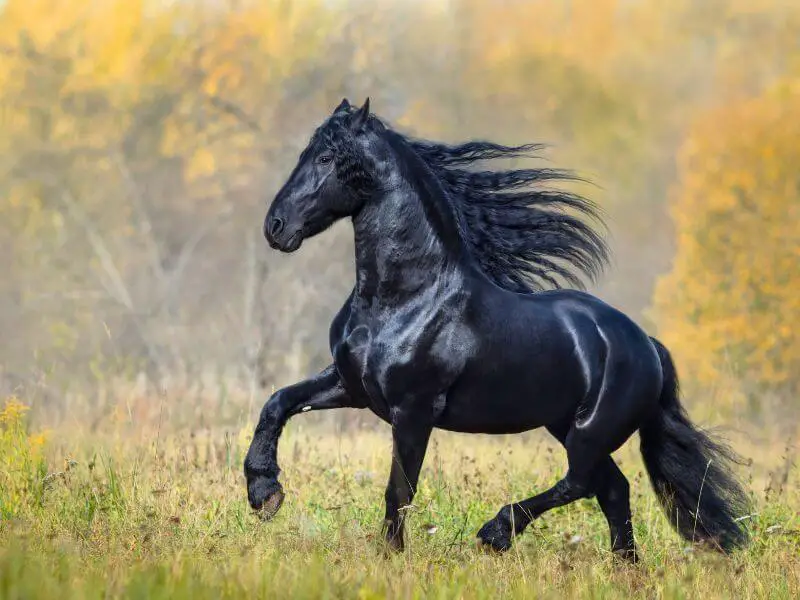
Genes Reponsible For Black Horses
In the realm of equine coat color genetics, black horses primarily have their color controlled by two genes: Extension and Agouti.
Extension Gene
The Extension gene, labeled “E,” is responsible for producing black pigment in the horse’s hair. Horses with at least one dominant E allele can produce black pigment. In contrast, those without it (homozygous recessive condition “ee”) lack black pigment and exhibit shades of red in their coats.
Agouti Gene
The Agouti gene, labeled “A,” restricts black pigment to specific areas of the coat, such as the legs, mane, and tail. Horses with at least one dominant A allele have their black pigment distributed in a pattern, resulting in a coat with a bay coloration. In the absence of this gene (homozygous recessive condition “aa”), black pigment is not restricted, and the coat appears uniformly black.
Defining a True Black Horse
To be considered a true black horse, an individual must have:
- At least one copy of the functional, dominant “E” allele from the Extension gene
- Two copies of the non-functional, recessive “a” allele from the Agouti gene.
This combination ensures the production of black pigment without any pattern restrictions. Therefore, an adult true black horse can be accurately described as possessing at least one dominant extension gene (EE or Ee) and no other dominant genes that modify color.
Note: DNA tests have been developed to identify the Extension and Agouti genotypes using hair samples with intact roots. However, no single test can definitively confirm a black horse. A combination of the extension test and the agouti test can help determine if a visually black horse is indeed black and not a dark bay or liver chestnut.
Homozygous Black Horses
Horses described as “homozygous black“ are homozygous for the dominant extension gene (EE). As a result, they can never produce a red foal. However, they may carry other genetic modifiers that influence coat color and patterns, which can be identified through further genetic testing.
Important Considerations for Breeders
For breeders interested in producing black horses, it is essential to consider the presence of the recessive “a” allele from the Agouti gene, in addition to the dominant “E” allele from the Extension gene, in their breeding stock.
This combination ensures the transmission of the black base coat color to their offspring.
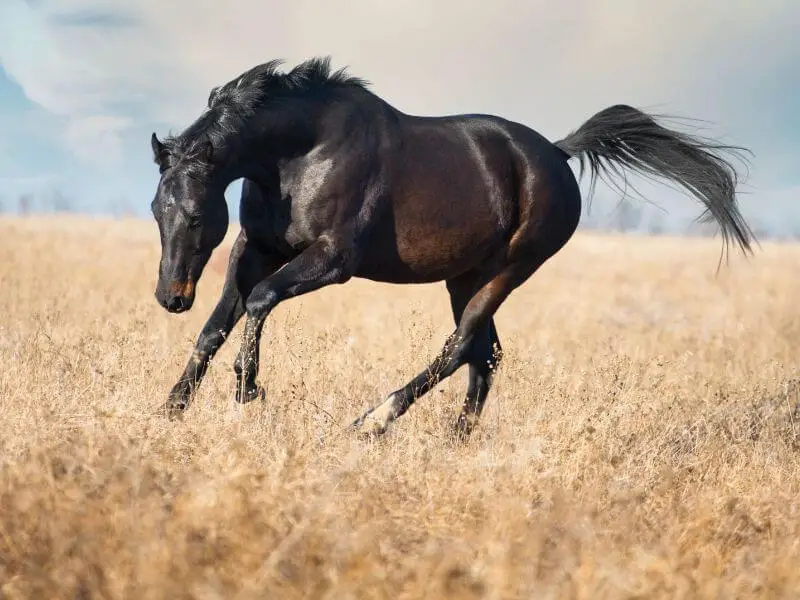
Confusion With Smoky Blacks And Other Colors
Certain coat colors can easily mimic black:
- Dark bay or seal brown horses, due to their dark shades, are often mistaken for black horses. However, they always exhibit some reddish characteristics in their coat.
- Liver chestnuts can also appear black and are sometimes referred to as “black chestnuts.” Despite their dark appearance, they still show some red character in their coat, especially around the pastern or in the mane or tail.
- Smoky blacks are the result of the minimal effect of the cream gene in the heterozygous condition on black pigment. They may look similar to true blacks, but are often born a pewter shade with blue eyes and typically retain reddish hair inside the ear through adulthood.
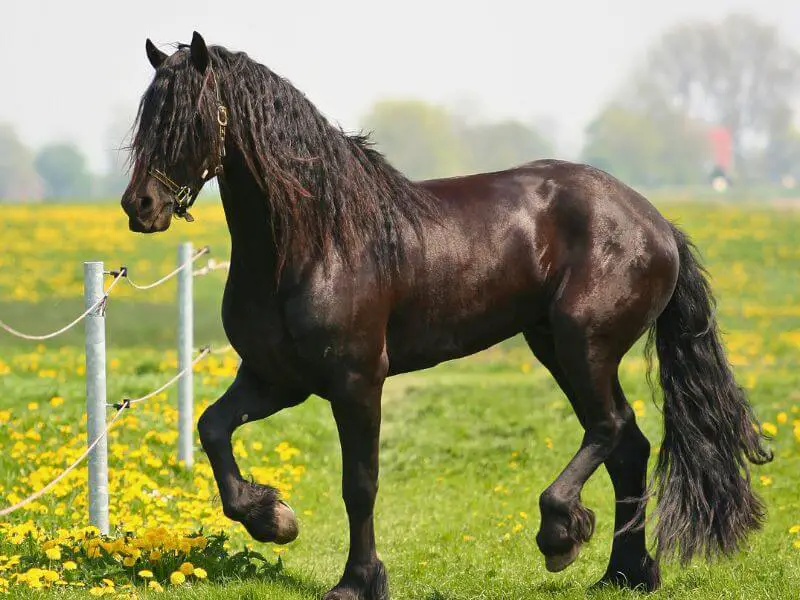
Black Horse Breeds
Let’s take a closer look at some well-known black horse breeds, each with their unique origins, distinctive features, and temperaments. We will unravel captivating tales and intriguing facts about these breeds. At the end, we will also introduce some other black horse breeds that you might find interesting.
Friesian: The Belgian Black
Also known as the Belgian Black, Friesians are a blend of power and grace. Adorned with long, flowing manes and tails, these horses capture attention wherever they go. During the Middle Ages, their strength made them popular war horses. Today, they are predominantly used for dressage and carriage driving.
Originating from Friesland in the Netherlands, the Friesian is an ancient breed that’s believed to have descended from the primitive Forest Horse. These horses are known for their intelligent, gentle nature, and noble bearing.
Fell Pony: Pride of the British Moorlands
Hailing from the harsh moorlands of Britain, Fell Ponies are noted for their silky black coat and long, flowing manes. Hardy, sure-footed, and robust, these ponies adapt to various riding and driving activities.
These ponies played an integral role in the British mining industry. Small yet mighty, they are cherished for their versatility, durability, and calm temperament, which makes them ideal for novice riders.
Dales Pony: The Elegant Northerner
Elegant, intelligent, and blessed with stamina, Dales Ponies have an uncanny resemblance to Fell Ponies. Their origins trace back to the rugged mountainous regions of northern England, where they’ve thrived for thousands of years. Ideal for both riding and driving, they are as versatile as they are beautiful.
In the face of World War II, the breed was almost wiped out as many Dales Ponies were requisitioned for use by the British army. Today, they are considered a vulnerable breed.
Murgese: The Italian Horse
The Murgese breed, known for its shimmering black coat, is as hardy as it is versatile. These Italian horses are often used as riding and light draft horses. Their tall, sporty build, characteristic outline, and hard hooves make them stand out.
Bred in the Murge, Apulia, they were used by Italian knights during the Middle Ages. These horses are admired for their calm demeanor and willingness to work.
Mérens Horse: The French Mountain Breed
The Mérens Horse, native to the French Pyrenees, is celebrated for its endurance and sure-footedness. This versatile breed excels in trail riding, displaying a black coat that matures beautifully over time.
Interestingly, they undergo a yearly transhumance, trekking up to high-altitude summer pastures and back down for winter, exhibiting their robust nature.
Percheron: The Elegant French Draft
Percherons are French draft horses admired for their elegance and agility. Predominantly black, grey is also a common color in this breed. Their large build and strength find use in agricultural work, forestry work, riding, and driving.
Their origins trace back to Huisne river valley in France, hence the name “Percheron.” These horses balance power and poise, which makes them suitable for various roles.
More Black Horse Breeds
Here are some other black horse breeds worth noting:
- Friesian Sporthorse: A crossbreed combining the athleticism and beauty of the Friesian with other sport horse breeds.
- Gypsy Vanner: Also known as the Irish Cob, originates from the British Isles and is known for their feathered legs and beautiful mane and tail.
- Warlander: A cross between the Friesian and the Andalusian, these horses inherit the grace and elegance of both parent breeds and excel in dressage.
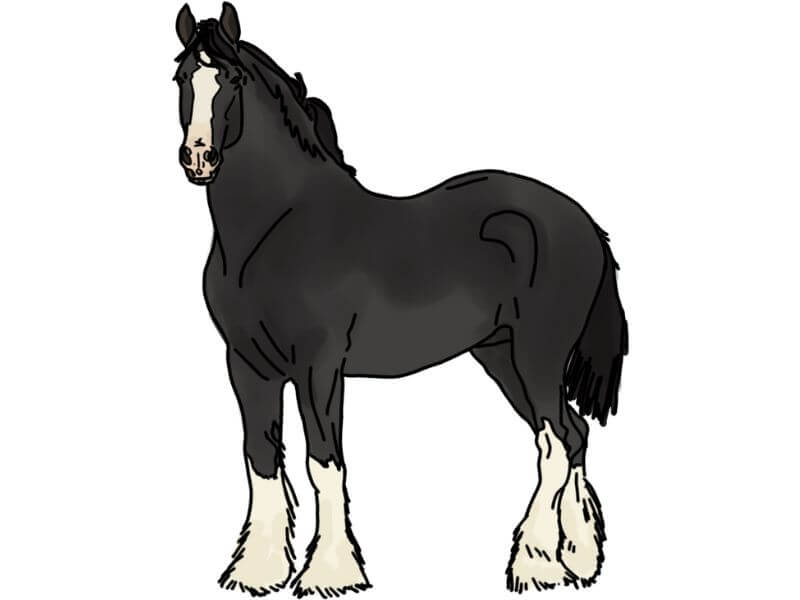
Black Horse Facts
- Color Genetics: Black and red (chestnut) are the two base colors in horses, and every other color is a modified version of these two. Black is dominant over chestnut, which means that horses can be homozygous black (carrying two copies of the black gene) or heterozygous black (carrying one copy of the black gene and one copy of the red gene).
- Breeding Black Horses: Two black horses can produce a black foal or a chestnut foal if they both carry a copy of the recessive chestnut gene. However, two black horses cannot produce a bay foal, but two bay horses can theoretically produce a black foal.
- Birth Coat: Many black horses are born with a unique shade of mouse-grey coat. Their true black coat color is revealed as their baby coat sheds out.
- Famous Black Horses in Literature: The classic children’s novel “Black Beauty” has sold over 50 million copies since its publication in 1877. Walter Farley’s “The Black Stallion” is also celebrated and has sold more than 12 million copies.
- Famous Real Black Horses: Queen Elizabeth II was gifted a black mare named Burmese by the Royal Canadian Mounted Police, and she rode Burmese during the Trooping the Color ceremonies for nearly twenty years. Black Gold, a black Thoroughbred, won the 1924 Kentucky Derby and was inducted into the Hall of Fame.
- Fading vs Non-Fading Blacks: Some black horses may “fade” in the summer sun and are called “fading blacks,” while others retain their ink-black coloring and are known as “non-fading blacks.”
- Sunburn Susceptibility: Black horses have a higher chance of developing sunburn compared to horses with lighter coat colors. Their dark pigmentation absorbs more sunlight, making them more susceptible to sunburn on exposed areas such as the muzzle and around the eyes.
- Seasonal Coat Variations: The intensity of a black horse’s coat color can vary throughout the year and with different seasons. Some black horses may appear to have a richer and deeper black coat during the winter months when their summer coat has shed.
- Show Ring Preference: Black horses with minimal or no white markings are often highly sought after in the show ring, as they are considered to have a more classic and elegant appearance.
- Symbolism: In some folklore and cultural beliefs, black horses are associated with mystery, power, and good luck. They are often depicted as symbols of strength and resilience.
- Disciplines: Black horses are known for their striking appearance in various disciplines, including dressage, driving, and show jumping. Their elegant movements and dramatic presence in the ring make them stand out among other horses.
- Coat Color Shades: Black horses can have different shades and variations within their coat color. Some may have a true jet-black coat, while others may have subtle brown or reddish undertones, especially when exposed to sunlight.
- Coat Maintenance: Black horses require regular grooming and maintenance to keep their coat looking its best. Regular brushing, proper nutrition, and good stable management practices contribute to maintaining a healthy and shiny black coat.
- Photography Challenges: Due to their dark color, black horses can be more challenging to photograph or film accurately, as capturing the details and nuances of their coat can be more difficult in certain lighting conditions.
- Equestrian Elegance: Black horses are often associated with elegance and sophistication in the equestrian world. Their sleek black coat and graceful movements make them popular choices for formal events and ceremonies.
- Cultural Significance: The symbolism of black horses varies across different cultures and traditions. In some cultures, black horses are associated with death or the afterlife, while in others, they are seen as symbols of power, protection, and magic.
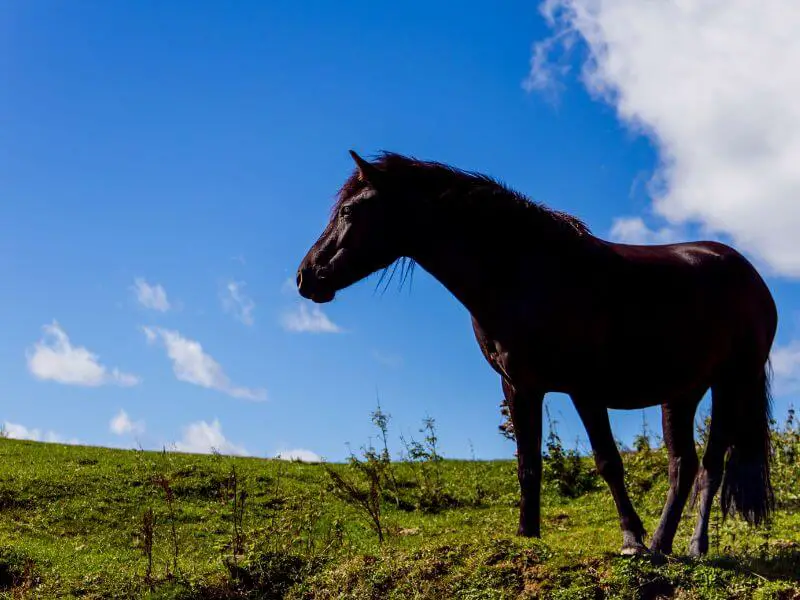
Are Black Horses Rare?
The rarity of black horses is a topic of debate. According to some sources, black is considered a relatively uncommon coat color in horses, while others argue that black horses are not exactly a rare coat color. It is important to note that some horses may appear black but are actually dark chestnuts or bays.
These colors can sometimes be mistaken for black. Additionally, certain black horses may experience “sun bleaching” when exposed to the elements and sweat, causing their coats to lose some of their rich black character and potentially resemble bay or seal brown.
There are two different types of black horses: “fading black” horses, whose black color fades into brown with sunlight exposure, and “non-fading black” horses that retain their black coat color regardless of sunlight exposure.
Some horse breeds, such as the Friesian, Murgese, and Ariegeois, are known for having predominantly black coats. However, finding a true black horse can be rare because many horses carry hidden colors in their genetic makeup. These hidden colors can influence the appearance of the coat.
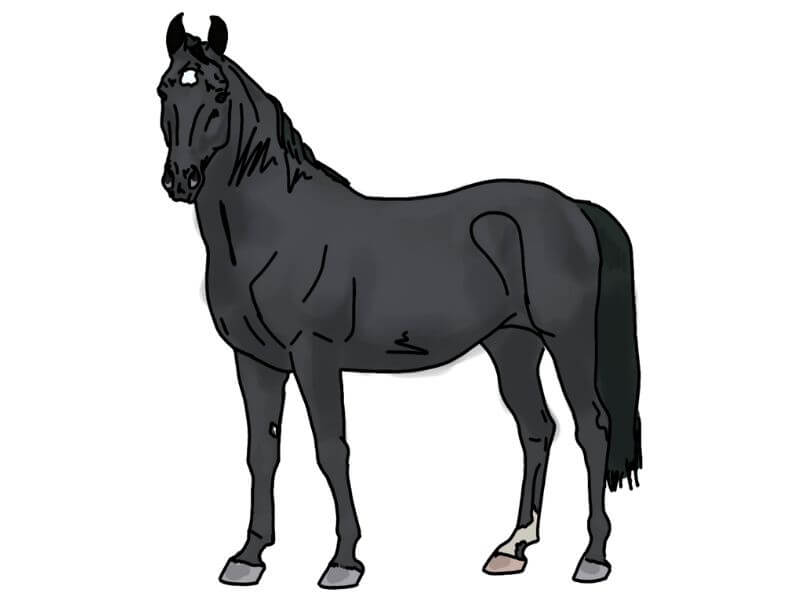
RELATED BLOG POST>> 139 Black Horse Names You Will Love
Conclusion
Black horses, with their mesmerizing coats and intriguing genetics, hold a certain allure in the equine world. Their rarity and elegance make them a subject of wonder and admiration.
However, the world of equine coat colors doesn’t stop at black. There’s a whole spectrum out there, filled with an array of stunning colors and fascinating genetics waiting to be explored.
From the fiery chestnuts and beautiful bays to the rare silver dapples and greys, each horse color carries its own unique charm and genetic code.
Understanding the genetics behind these colors not only satisfies our curiosity but deepens our appreciation for these majestic creatures.
To navigate the captivating world of equine colors, we encourage you to explore our other blog posts. Each post dives into a different color, revealing the unique traits and fascinating genetics that define it.
Whether you’re a horse lover, an owner, a breeder, or someone simply fascinated by equine genetics, you’re sure to find something to pique your interest.
Remember, every horse color has a story to tell. The more we uncover these stories, the more we appreciate the diversity and richness of the equine world. So, let’s continue learning, exploring, and appreciating these beautiful animals together.
Happy reading!
If you’re eager to learn more about horses, make sure to check out our other related blog posts.
Cheers, Kacey
P.S. Did you like this article? Gallop over to:

